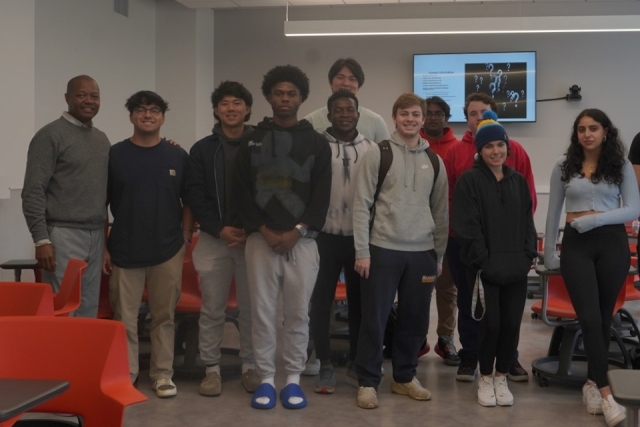
Students in Professor Lequez Spearman's Sport Management classes attended the lecture given by Dr. Marcus Amos.
The danger of opioid dependency among athletes was explored with St. John’s University students on October 24 by a leading voice on addiction and substance-abuse rehabilitation.
Marcus Amos, Ph.D., a certified alcohol and drug abuse counselor, player development specialist, and Assistant Professor of Sport Management at Voorhees University in Denmark, SC, addressed a gathering of students from The Lesley H. and William L. Collins College of Professional Studies, discussing, among other things, a wave of opioid-related deaths among young athletes.
Dr. Amos documented the deaths of six college athletes from drug- and depression-related suicides in 2022–23—but those, he said, were only the high-profile examples. Many others are underreported.
“We have receptors in our brains that detect everything,” Dr. Amos explained. “Opioids are very effective at destroying the particular receptors that fight off cravings for other drugs, so you start having cravings for substances you’ve never even thought about using before—and you become addicted.”
Dr. Amos earned his doctoral degree in Kinesiology and Sport Studies at the University of Tennessee and has worked with the athletic departments of Louisiana State University and the universities of Alabama and Tennessee. He came to St. John’s at the invitation of Lequez Spearman, Ph.D., Associate Professor, Division of Sport Management, who recognizes Dr. Amos’ leadership in the field of substance abuse counseling.
“Dr. Amos has a unique ability to break down abstract ideas so that they are practical for career readiness and more importantly, life-and-death situations,” Dr. Spearman said. “Students often ask the proverbial question: Why should I care? There is no one better to answer that question than Dr. Amos. He easily teases out the racialized and gendered aspects of drug abuse and crisis prevention among athletes.”
According to Dr. Amos, athletes can be especially vulnerable to opioid addiction. Prescription drugs used to combat injuries become gateways to other, more dangerous medications. Also, the inability to play due to injury can leave many athletes depressed; all six of the athletes Dr. Amos presented evidenced signs of depression.
Pointing to his video monitor, Dr. Amos said: “Every single person up here started with a legitimate injury and transitioned to use medication outside of the realm of the doctor. They got addicted because they just couldn’t deal with the injuries.”
“Anxiety is real among athletes,” Dr. Amos continued. “Anti-anxiety medication, like benzodiazepine, is a depressant. Alcohol is a depressant. Opioids are depressants. Imagine you’re taking all three of those at the same time? What’s going to happen? You’re going to be very depressed.”
In recent years, an additional danger has developed, Dr. Amos added. Fentanyl is less expensive to manufacture than other opioids, but is more than 100 times more powerful than morphine and more than 50 times more powerful than heroin, according to the US Drug Enforcement Administration.
Fentanyl is deadly in even the smallest doses. According to the Centers for Disease Control and Prevention, 150 people die every day from overdoses related to synthetic opioids such as fentanyl. As athletes use opioids and other drugs, they increase the chance of consuming drugs laced with fentanyl, which can be deadly.
“When we talk about all those things athletes transition to when regular opioids aren’t effective anymore, fentanyl is four times more prevalent than other drugs,” Dr. Amos said. “If fentanyl touches your pinkie it could kill you depending on how strong your system is.”
To minimize the risk of drug-induced deaths and suicides among athletes, Dr. Amos proposes a “holistic-care model” that involves coaches, trainers, parents, teammates, teachers, clergy, school counselors, and others all acting in support of the athlete.
“College athletes will come for support in all those areas,” Dr. Amos said. “And it remains so as they transition to the professional level. The money they’ll earn doesn’t mask the need for this kind of support.”
Related News
Alumna Celebrates Book Launch After Career Change
After developing a passion for helping the younger generation, Ashley Wilson ’14M.S.Ed. pivoted from a career in the music industry to work as an educator. She is also making her mark through her new...
Dean Jerrold Ross Conference Room Unveiled
On Tuesday, December 10, the newly renovated conference room on the fifth floor of Sullivan Hall was dedicated in honor of Jerrold Ross, Ph.D., former Dean of The School of Education . The renovation...
Institute for Catholic Schools Provides Educational Resources to Local Catholic School
The Institute for Catholic Schools (ICS) in The School of Education at St. John’s University recently donated approximately $2,800 worth of academic and sensory learning tools to Father Vincent...
